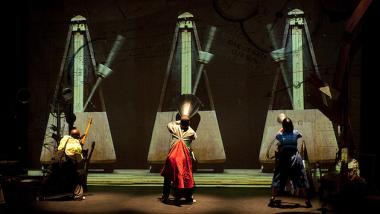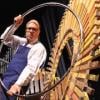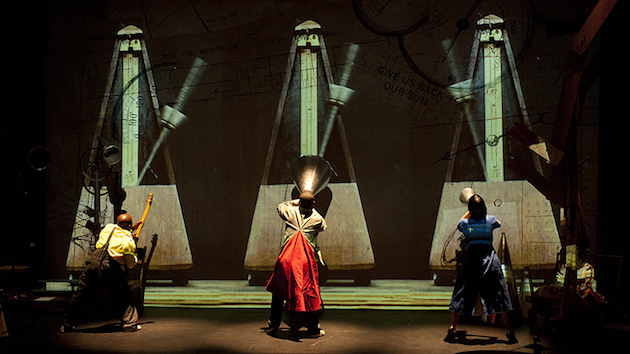
South African artist William Kentridge is something of a sorcerer. Through charcoal drawing, stop motion, sculpture, film, and stagecraft, he summons inanimate objects to life, making them perform manic little dances and acrobatics before the spell wears off and they disintegrate into scraps of paper or bits of junk. Last Friday, Kentridge invited San Francisco audiences at A.C.T.’s Geary Theater into the bizarre and enchanting world of his music-theater work Refuse the Hour, which combines feats of mechanical wizardry with unexpectedly profound social commentary.
Although it’s billed as a “chamber opera,” Refuse the Hour is really something of a multimedia revue. Kentridge himself served as the show’s emcee; donning his signature pince-nez glasses, the impish, white-haired artist stood at a podium and delivered several short lectures on scientific topics. These texts alternated with eccentric vaudeville interludes performed by a small troupe of singers, dancers, actors, and instrumentalists. It all had the circus-like character of an avant-garde “happening.” In the opening number, for instance, megaphone-wielding ensemble members verbally accosted a trio of enormous metronomes projected onstage, shouting tempo directions like “largo,” “moderato,” and “allegro” at the giant time-beating devices.
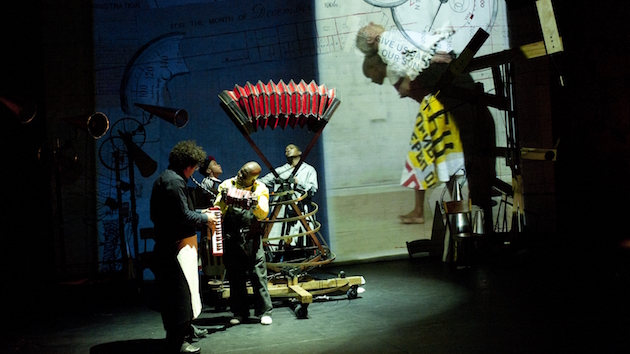
The work originated with a series of conversations between Kentridge and Peter Galison, a Harvard history-of-science professor. Their discussions on 19th- and early 20th-century physics inspired Kentridge’s 2012 installation The Refusal of Time, recently on display at SFMOMA. Refuse the Hour, a theatrical companion piece, deals with the same topics as the exhibit: time, space, entropy, relativity, and technology. In his lectures (written with Galison’s dramaturgical assistance), Kentridge related these heady topics to our everyday experience. The invention of moving pictures, for instance, he interpreted as a manifestation of the desire to replay our actions, or undo them, as the case may be, by reversing the images.
The interludes provided further reflection, translating the concepts presented in the lectures into multimedia events. In a sequence of Georges Méliès-style silent films that Kentridge created with video designer Catherine Meyburgh, absurdist scenes featuring the onstage cast were played forward and backward. In one film, reverse editing allowed swirling charcoal flakes to magically condense, spelling out the words “UNDO” and “UNSAY.” This theme was transferred to the realm of sound in an uncanny episode. South African contralto Ann Masina, perched up in one the theater’s boxes, sang a luxurious rendition of “Le spectre de la rose” from Berlioz’ Les nuits d'été. Every so often, soprano Joanna Dudley would interrupt the number with backward echoes of Masina’s phrases, singing the pitches and phonemes in reverse order, as if a gramophone record were being dragged the wrong way across the needle.
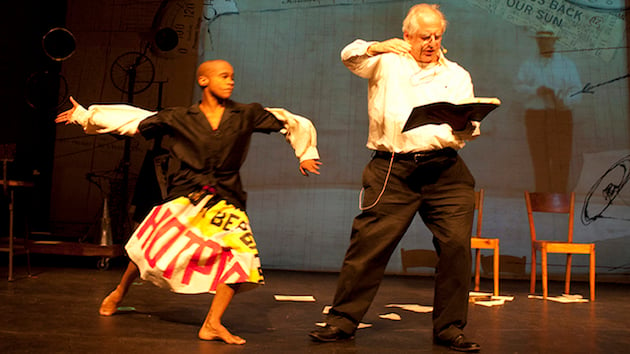
Kentridge’s engagement with vintage science and technology is indicative of his obsession with the intellectual and artistic environment of a century past. If you didn’t know any better, you might guess that Refuse the Hour was a product of the 1910s rather than the 2010s. Kentridge’s style draws heavily on Dadaism and Surrealism — his recent Met Opera productions of Shostakovich’s The Nose and Berg’s Lulu, for example, feature wacky animated collages resembling the works of Kurt Schwitters or Max Ernst. These collages made their way into the stage design for Refuse the Hour, including a backdrop of yellowed drafting sketches and Greta Goiris’ colorful costumes, which incorporated fabric made to look like print material. Cluttering the stage were ridiculous machines assembled from found objects; one particularly strange apparatus constructed of a tripod and a bicycle wheel looked suspiciously like a readymade sculpture by Marcel Duchamp.
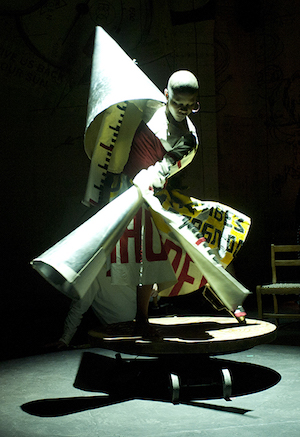
The choreography, too, felt straight out of the first decades of the 20th century. Dancer Dada Masilo performed hypnotic spins reminiscent of Loie Fuller’s “serpentine” dances, which so inspired artists of the Art Nouveau and Symbolist movements. Projected behind Masilo during her solos was a dancing animated double composed of newspaper clippings. At one point, Dada herself became a work of Dadaist sculpture: placing megaphones on her arms and one of her legs, the dancer struck a series of angular poses as Kentridge spun her in circles on a rotating platform. It was a thrilling and disturbing sight—a kind of Futurist dream of the human body as a sleek, metallic machine.
Cape Town-based composer Philip Miller, a frequent collaborator with both Kentridge and Masilo, provided a whimsical score for the proceedings. His music draws on popular turn-of-the-century and jazz-age styles—the onstage cabaret band swung their way through catchy tangos, shimmies, rags, and foxtrots. There was even an interesting bit of authentic “period performance” in yet another variation on the show’s many megaphones; violinist Waldo Alexander equipped his instrument with a metal Stroh horn, a miniature projecting device that gave his violin the tinny sound of a gramophone recording or radio broadcast.
To the show’s collection of odd machines, Miller added his own musical contraptions, including a crank-operated barrel organ. Hanging from the top of the proscenium was a kind of one-man percussion band that you’d find among the coin-operated nickelodeons and pianolas at the Musée Mécanique on Fisherman’s Wharf. Unseen hands pulled a series of strings that set the gadget into asynchronous ticking and tocking — a musical reference to Kentridge’s lectures on time.
In fact, most of Miller’s musical material cleverly riffed on the show’s themes. When Kentridge described a system of pneumatic tubes that transmitted time signals throughout 19th-century Paris in the form of puffs of air, the band broke into a syncopated “pumping” number, with trombonist Dan Selsick and tubist Thobeka Thukane offering some marvelously buzzing oom-pah accompaniments for Adam Howard’s golden-toned trumpet solo. In response to Kentridge’s musings on entropy, many of the interludes descended into musical chaos, with the instrumentalists and actors erupting in a hectic barrage of overlapping melodies and goofy sound effects. During these crazy moments, I especially enjoyed watching vocalist Joanna Dudley, who, with her bobbed haircut and hyperactive Charleston steps, looked like a character from some 1920s Walt Disney cartoon.
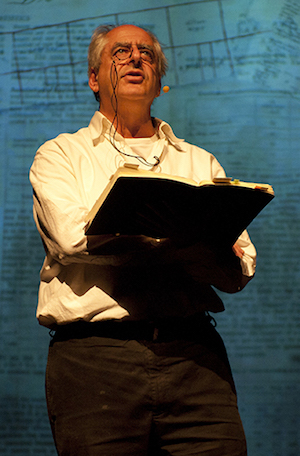
With all these historical references, I couldn’t help but wonder if Kentridge’s nostalgic return to early Modernism was simply an elaborate attempt to avoid the present. Yet over the course of the performance, it became clear that Refuse the Hour subtly uses the past as a lens (or a pince-nez) through which we can observe and better understand our contemporary state. Kentridge, whose lawyer parents defended victims of South African apartheid, is particularly concerned with the subject of modern-day race relations. His work often grapples with racial inequality and post-colonialism, notably his bleak, 1989 animated film Johannesburg.
But to better understand the events that led up to apartheid, Kentridge rewound the clock of colonial history in Refuse the Hour. During an especially telling lecture-interlude combo, he described the 19th-century etching of time zones across the globe as a means of colonial control — the “official” noon in the Belgian Congo or French West Africa were determined by European time-keepers and no longer corresponded to the point in the day when the sun reached its zenith. Kentridge argued that various African uprisings such as the 1906 Herero Revolt in German South West Africa (present-day Namibia) or the 1915 Chilembwe Revolt of Nyasaland (modern-day Malawi) can be read as a “refusal of the hour” imposed by colonial powers.
Following Kentridge’s lecture, Ann Masina burst into an anthem-like aria with a driving instrumental accompaniment informed by traditional sub-Saharan music. Holding her black fist high over her head, she decried the burden of European rule, belting out, “Give us back our sun!” In a powerful moment of historical transcendence, Masina’s revolutionary number seemed to encompass a century of struggle for the African and African-diaspora peoples — from the Anti-Apartheid and American Civil Rights movements to the continued fight against racial injustice in both the U.S. and South Africa today.

